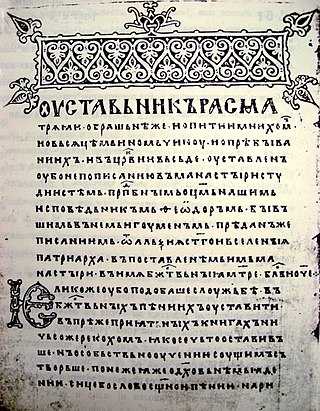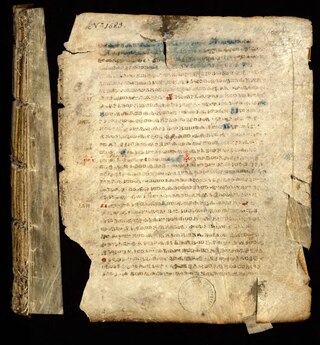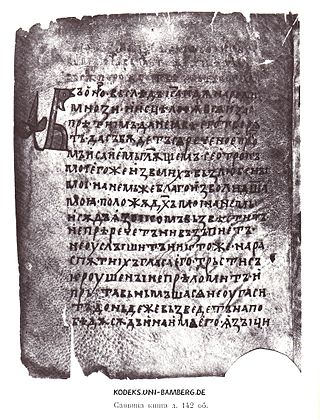
Old Church Slavonic or Old Slavonic is the first Slavic literary language.

The Freising manuscripts are the first Latin-script continuous text in a Slavic language and the oldest document in Slovene.

Supraśl is a town and former episcopal see in north-eastern Poland.

The Early Cyrillic alphabet, also called classical Cyrillic or paleo-Cyrillic, is an alphabetic writing system that was developed in Medieval Bulgaria in the Preslav Literary School during the late 9th century. It is used to write the Church Slavonic language, and was historically used for its ancestor, Old Church Slavonic. It was also used for other languages, but between the 18th and 20th centuries was mostly replaced by the modern Cyrillic script, which is used for some Slavic languages, and for East European and Asian languages that have experienced a great amount of Russian cultural influence.

The Codex Beneventanus is an 8th-century illuminated codex containing a Gospel Book. According to a subscription on folio 239 verso, the manuscript was written by a monk named Lupus for one Ato, who was probably Ato, abbot (736–760) of the monastery of San Vincenzo al Volturno, near Benevento. The unusual odd number of Canon Tables suggests these seven folios were prepared as much as two centuries earlier than the rest of the codex.

The Vercelli Book is one of the oldest of the four Old English Poetic Codices. It is an anthology of Old English prose and verse that dates back to the late 10th century. The manuscript is housed in the Capitulary Library of Vercelli, in northern Italy.

The Samarkand Kufic Quran is an 8th or 9th century manuscript Quran written in the territory of modern Iraq in the Kufic script, where it was later taken by Tamerlane to Samarkand. Today it is kept in the Hast Imam library, in Tashkent, Uzbekistan.

The National Library is the central Polish library, subject directly to the Ministry of Culture and National Heritage of the Republic of Poland.

Laurentian Codex or Laurentian Letopis is a collection of chronicles that includes the oldest extant version of the Primary Chronicle and its continuations, mostly relating the events in the northeastern Rus' principalities of Vladimir-Suzdal.
The Codex Zographensis is an illuminated Old Church Slavonic canon manuscript. It is composed of 304 parchment folios; the first 288 are written in Glagolitic containing Gospels and organised as Tetraevangelium, and the rest written in Cyrillic containing a 13th-century synaxarium. It is dated back to the end of the 10th or beginning of the 11th century.

The Codex Marianus is an Old Church Slavonic fourfold Gospel Book written in Glagolitic script, dated to the beginning of the 11th century, which is, one of the oldest manuscript witnesses to the Old Church Slavonic language, one of the two fourfold gospels being part of the Old Church Slavonic canon.

The Kiev Missal is a seven-folio Glagolitic Old Church Slavonic canon manuscript containing parts of the Roman-rite liturgy. It is usually held to be the oldest and the most archaic Old Church Slavonic manuscript, and is dated at no later than the latter half of the 10th century. Seven parchment folios have been preserved in small format of easily portable book to be of use to missionaries on the move.
Codex Assemanius is a rounded Glagolitic Old Church Slavonic canon evangeliary consisting of 158 illuminated parchment folios, dated to early 11th century. The manuscript is created in the Ohrid Literary School of the First Bulgarian Empire.

The Psalterium Sinaiticum is a 209-folio Glagolitic Old Church Slavonic canon manuscript, the earliest Slavic psalter, dated to the 11th century. The manuscript was found in Saint Catherine's Monastery in Egypt, after which it was named and where it remains to this day.

The Glagolita Clozianus is a 14-folio Glagolitic Old Church Slavonic canon miscellany, written in the eleventh century.

Sava's book is a 129-folio Cyrillic Old Church Slavonic canon evangeliary, written in the 11th century.

Minuscule 569, A 151, is a Greek minuscule illuminated manuscript Gospel book, on parchment. It is dated by a Colophon to the year 1061. It was labelled by Scrivener as 475. The manuscript has complex contents.
Minuscule 653, ε 182, is a Greek minuscule manuscript of the New Testament, on parchment. It is dated by a colophon to the year 1077. The manuscript has not complex contents. Scrivener labelled it by 640e.
Codex Sinaiticus Rescriptus, mostly originating in Saint Catherine's Monastery, Sinai from Sin. Georg. 34; Tsagareli 81, is an accumulation of nineteen Christian Palestinian Aramaic palimpsest manuscripts containing Old Testament, Gospel and Epistles pericopes of diverse Lectionaries, among them two witnesses of the Old Jerusalem Lectionary, various unidentified homilies and two by John Chrysostom, hagiographic texts as the Life of Pachomios, the Martyrdom of Philemon Martyrs, and the Catecheses by Cyril of Jerusalem. The palimpsests manuscripts are recycled parchment material that were erased and reused by the tenth century Georgian scribe Ioane-Zosime for overwriting them with homilies and a Iadgari. Part of the parchment leaves had been brought by him from the Monastery of Saint Sabas, south of Jerusalem in the Kidron Valley, when he moved to St Catherine's Monastery and became there librarian. In the nineteenth century most of the codex was removed from the monastery at two periods. C. Tischendorf took two thirds in 1855 and 1857 with the Codex Sinaiticus to St Peterburg and handed it over to the Imperial Library, now the National Library of Russia, and the remaining third left on a clandestine route [so-called collection of Dr Friedrich Grote (1862-1922)] and found its way into various European and later also into US collections, at present in a Norwegian collection. From the New Finds of 1975 in the Monastery of Saint Catherine missing folios of some of the underlying manuscripts could be retrieved, with one connected to Princeton, Garrett MS 24.
The Suzdalian Chronicle, also known as the Chronicle of Vladimir-Suzdal, Suzdal–Vladimirian Chronicle or Laurentian–Radziwiłł–Academic Chronicle (LRAC), is a Rus' chronicle, covering events from 1111 to 1305 in Kievan Rus' and its subsequent Rus' principalities under the dominion of the Golden Horde. It has a pro-Yurievichi dynastic Tendenz, and a focus on the northeastern principalities of Vladimir-Suzdal, where it was compiled in the 14th century. It is one of several continuations of the Primary Chronicle (PVL), and its oldest copy is found in columns 289–437 of the Laurentian Codex of 1377. Other copies can be found in the Radziwiłł Chronicle, the Academic Chronicle, and the Chronicler of Pereyaslavl-Suzdal.















